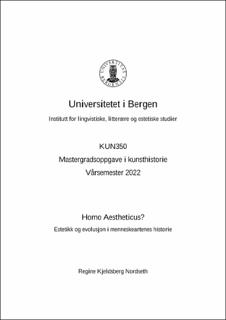Homo Aestheticus? Estetikk og evolusjon i menneskeartenes historie
Master thesis
Permanent lenke
https://hdl.handle.net/11250/2999139Utgivelsesdato
2022-05-20Metadata
Vis full innførselSamlinger
- Master theses [242]
Sammendrag
Have human beings always made and appreciated art? Rock art, cave paintings, figurines and movable objects are just a few examples of the magnificent prehistoric art forms, that have been preserved. They can all be viewed as expressions of aesthetic appreciation, artistic innovation, creativity, and cognition. Therefore, the question arises; have hominins always been a Homo Aestheticus? Prehistoric art is a highly varied field with great aesthetic qualities. Traditionally, it has been categorized into the field of archaeology, despite having art in its name. This has led to a one-sided perspective in research. The aesthetic parts of prehistoric art have been trivialized in favor of a more archaeologic focus. Why has the art of the paleolithic period not been included in an art-historic context? Has the Eurocentric and post-Kantian attitude excluded prehistoric art and artifacts from being assimilated into the field of art history? This thesis focuses on the evolution of aesthetics, i.e., how aesthetics and hominin evolution have been interwoven. Moreover, how interpretation and definition of art has affected how prehistoric art is viewed today. The prior used term Homo Aestheticus was coined by scholar Ellen Dissanayake, who has an anthropological approach to art. By this term I mean all the hominine species, not just Homo sapiens. This thesis focus on prehistoric aesthetic heritage, drawing on art history, in addition to neurobiology and neuroaesthetics, as well as on how expressions of aesthetic appreciation in hominin history have displayed themselves. Seven features of aesthetic appreciation, manifested throughout history, will be identified within varying species. To name a couple, the unmodified pebble of Makapansgat, the Acheuléans’ symmetrical hand axes, rock art, the use of tools among the great apes, the use of pigments, and the use of figurative motifs. How are these aesthetic characteristics linked to brain evolution in the hominin lineage? In Dissanayake’s definition of art, she uses the term artification, meaning “making ordinary reality extraordinary.” Based on this principle, I will argue that prehistoric art, in every way and form, qualify as art. Substantiating this theory with the given research further discussed in this thesis, the conclusion will be that humans have always been Homo Aestheticus.
